Self-Awareness and Professional Development
VerifiedAdded on 2020/04/07
|16
|4806
|124
AI Summary
This assignment delves into the crucial role of self-awareness in shaping professional development within the tourism industry. It examines various aspects of self-awareness, including its impact on personal growth, interpersonal relationships, decision-making abilities, and overall job performance. Students are encouraged to analyze case studies, research relevant theories, and reflect on their own experiences to understand the profound influence of self-awareness on success in the dynamic field of tourism.
Contribute Materials
Your contribution can guide someone’s learning journey. Share your
documents today.
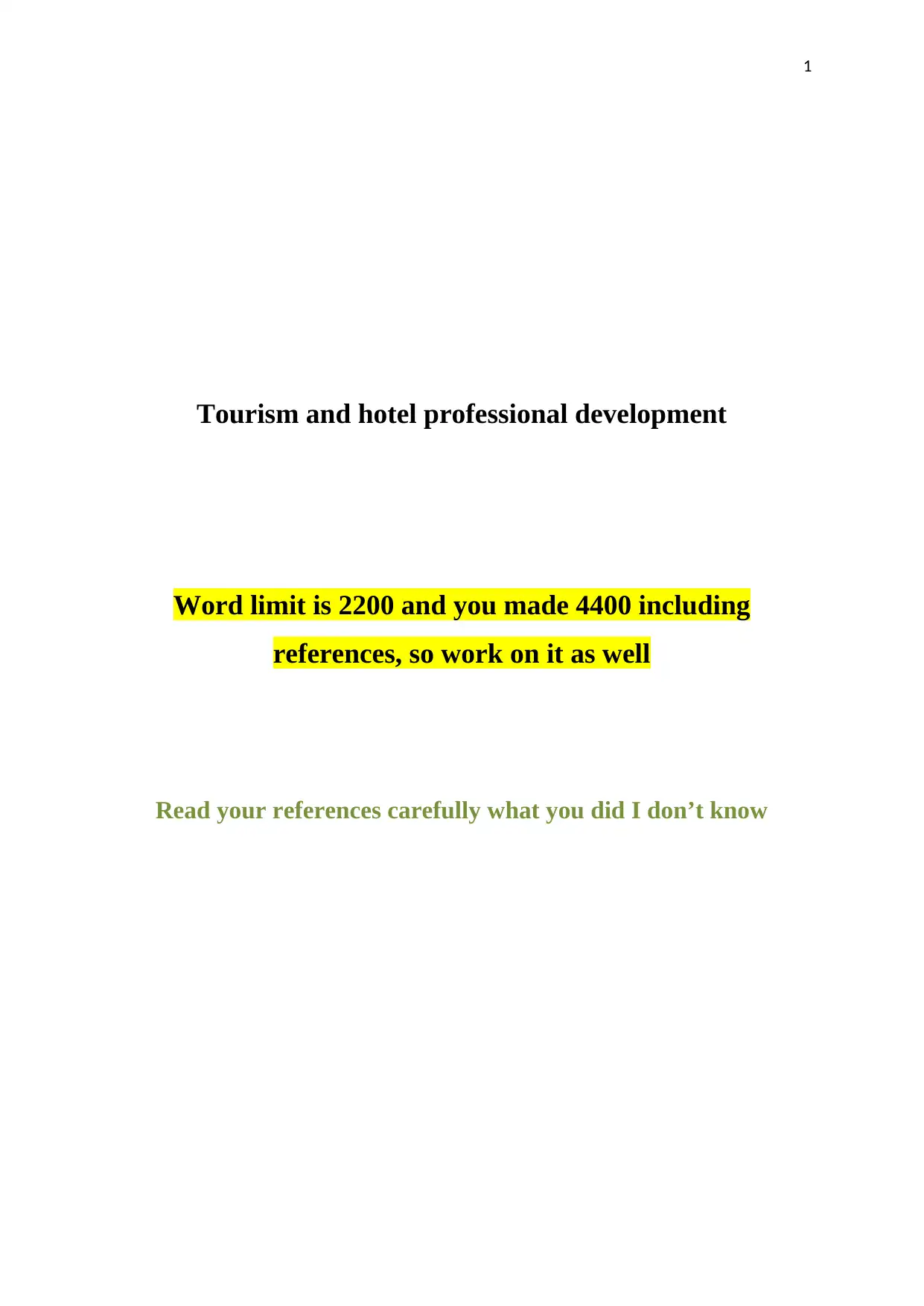
1
Tourism and hotel professional development
Word limit is 2200 and you made 4400 including
references, so work on it as well
Read your references carefully what you did I don’t know
Tourism and hotel professional development
Word limit is 2200 and you made 4400 including
references, so work on it as well
Read your references carefully what you did I don’t know
Secure Best Marks with AI Grader
Need help grading? Try our AI Grader for instant feedback on your assignments.
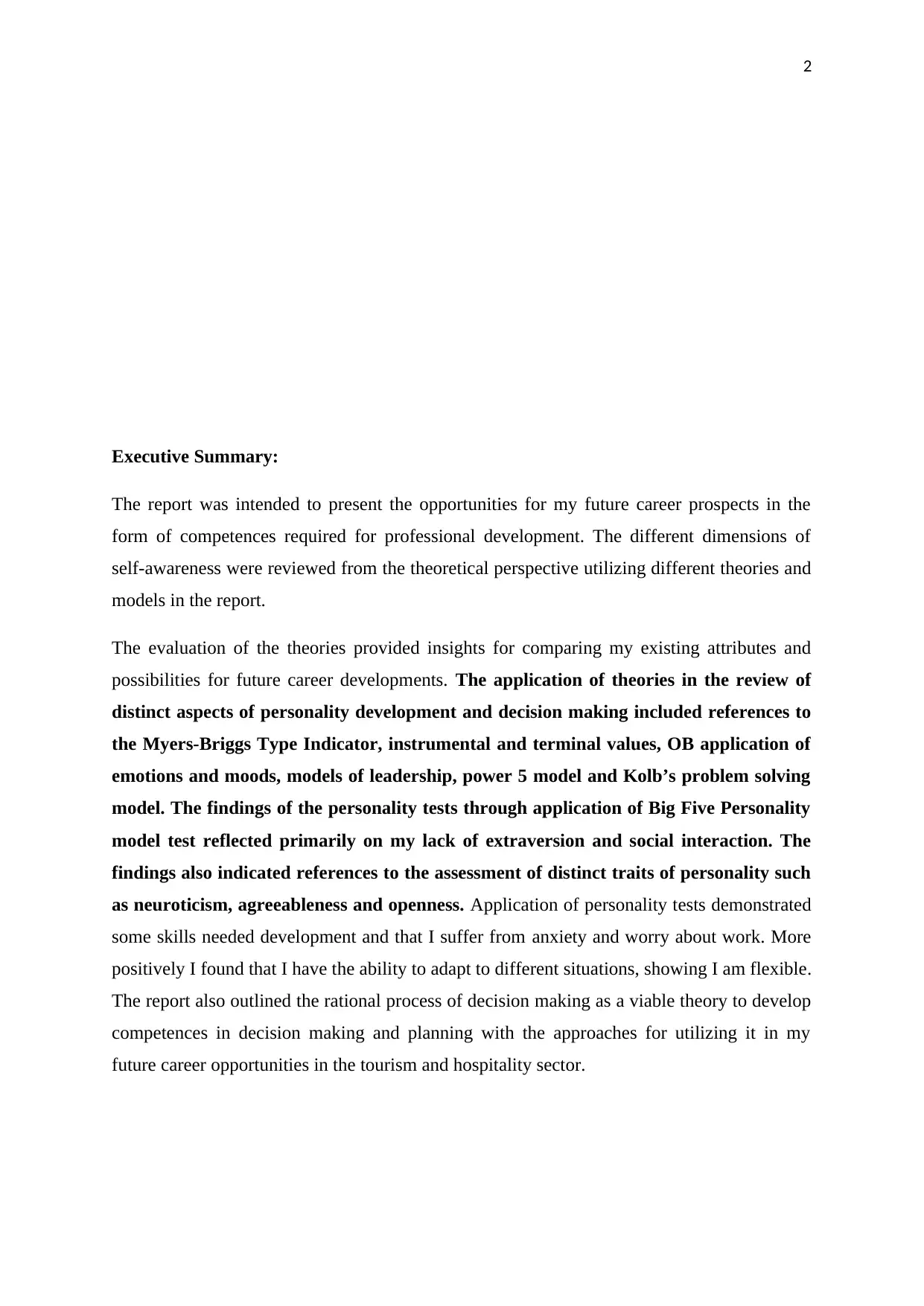
2
Executive Summary:
The report was intended to present the opportunities for my future career prospects in the
form of competences required for professional development. The different dimensions of
self-awareness were reviewed from the theoretical perspective utilizing different theories and
models in the report.
The evaluation of the theories provided insights for comparing my existing attributes and
possibilities for future career developments. The application of theories in the review of
distinct aspects of personality development and decision making included references to
the Myers-Briggs Type Indicator, instrumental and terminal values, OB application of
emotions and moods, models of leadership, power 5 model and Kolb’s problem solving
model. The findings of the personality tests through application of Big Five Personality
model test reflected primarily on my lack of extraversion and social interaction. The
findings also indicated references to the assessment of distinct traits of personality such
as neuroticism, agreeableness and openness. Application of personality tests demonstrated
some skills needed development and that I suffer from anxiety and worry about work. More
positively I found that I have the ability to adapt to different situations, showing I am flexible.
The report also outlined the rational process of decision making as a viable theory to develop
competences in decision making and planning with the approaches for utilizing it in my
future career opportunities in the tourism and hospitality sector.
Executive Summary:
The report was intended to present the opportunities for my future career prospects in the
form of competences required for professional development. The different dimensions of
self-awareness were reviewed from the theoretical perspective utilizing different theories and
models in the report.
The evaluation of the theories provided insights for comparing my existing attributes and
possibilities for future career developments. The application of theories in the review of
distinct aspects of personality development and decision making included references to
the Myers-Briggs Type Indicator, instrumental and terminal values, OB application of
emotions and moods, models of leadership, power 5 model and Kolb’s problem solving
model. The findings of the personality tests through application of Big Five Personality
model test reflected primarily on my lack of extraversion and social interaction. The
findings also indicated references to the assessment of distinct traits of personality such
as neuroticism, agreeableness and openness. Application of personality tests demonstrated
some skills needed development and that I suffer from anxiety and worry about work. More
positively I found that I have the ability to adapt to different situations, showing I am flexible.
The report also outlined the rational process of decision making as a viable theory to develop
competences in decision making and planning with the approaches for utilizing it in my
future career opportunities in the tourism and hospitality sector.
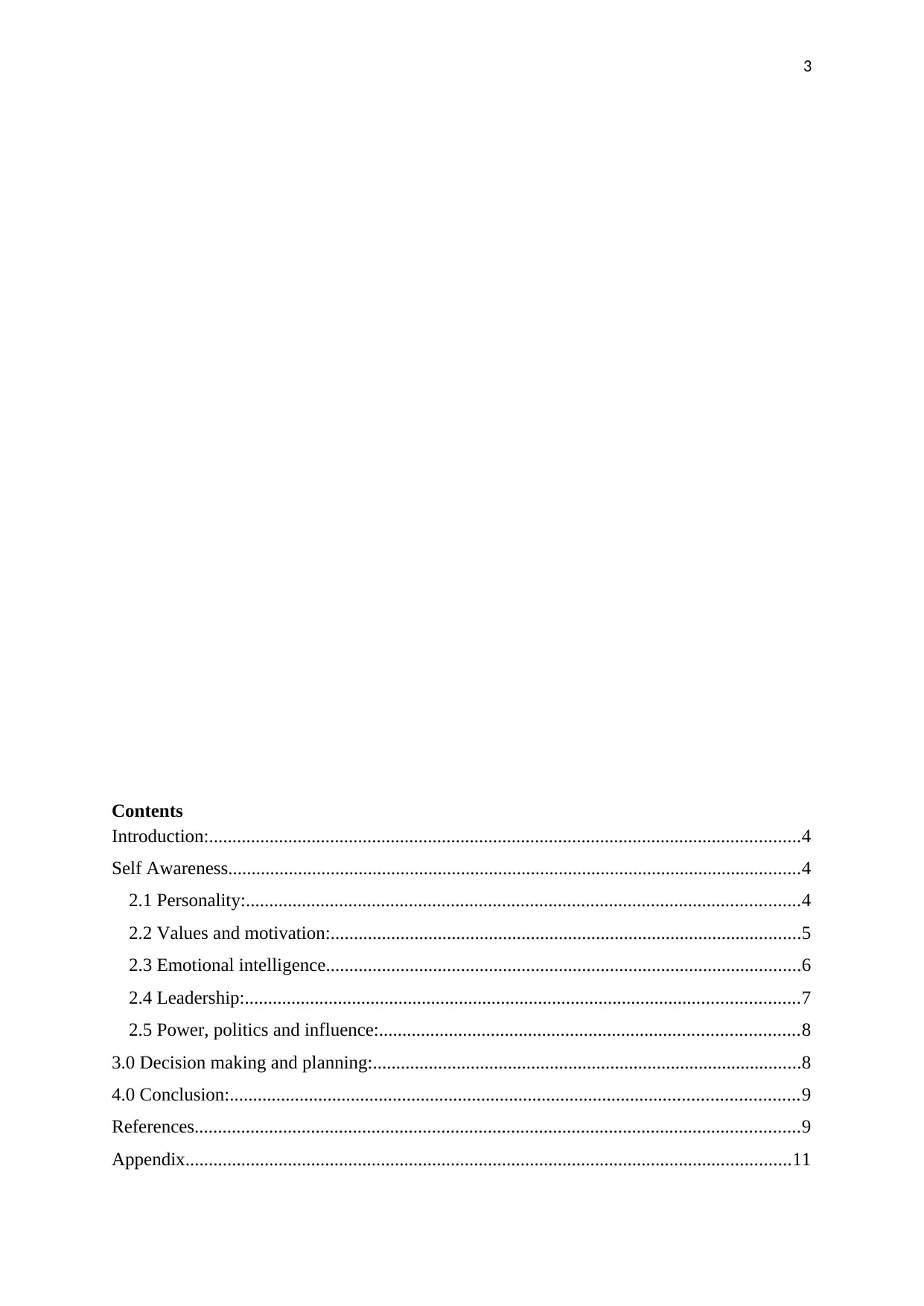
3
Contents
Introduction:...............................................................................................................................4
Self Awareness...........................................................................................................................4
2.1 Personality:.......................................................................................................................4
2.2 Values and motivation:.....................................................................................................5
2.3 Emotional intelligence......................................................................................................6
2.4 Leadership:.......................................................................................................................7
2.5 Power, politics and influence:..........................................................................................8
3.0 Decision making and planning:............................................................................................8
4.0 Conclusion:..........................................................................................................................9
References..................................................................................................................................9
Appendix..................................................................................................................................11
Contents
Introduction:...............................................................................................................................4
Self Awareness...........................................................................................................................4
2.1 Personality:.......................................................................................................................4
2.2 Values and motivation:.....................................................................................................5
2.3 Emotional intelligence......................................................................................................6
2.4 Leadership:.......................................................................................................................7
2.5 Power, politics and influence:..........................................................................................8
3.0 Decision making and planning:............................................................................................8
4.0 Conclusion:..........................................................................................................................9
References..................................................................................................................................9
Appendix..................................................................................................................................11
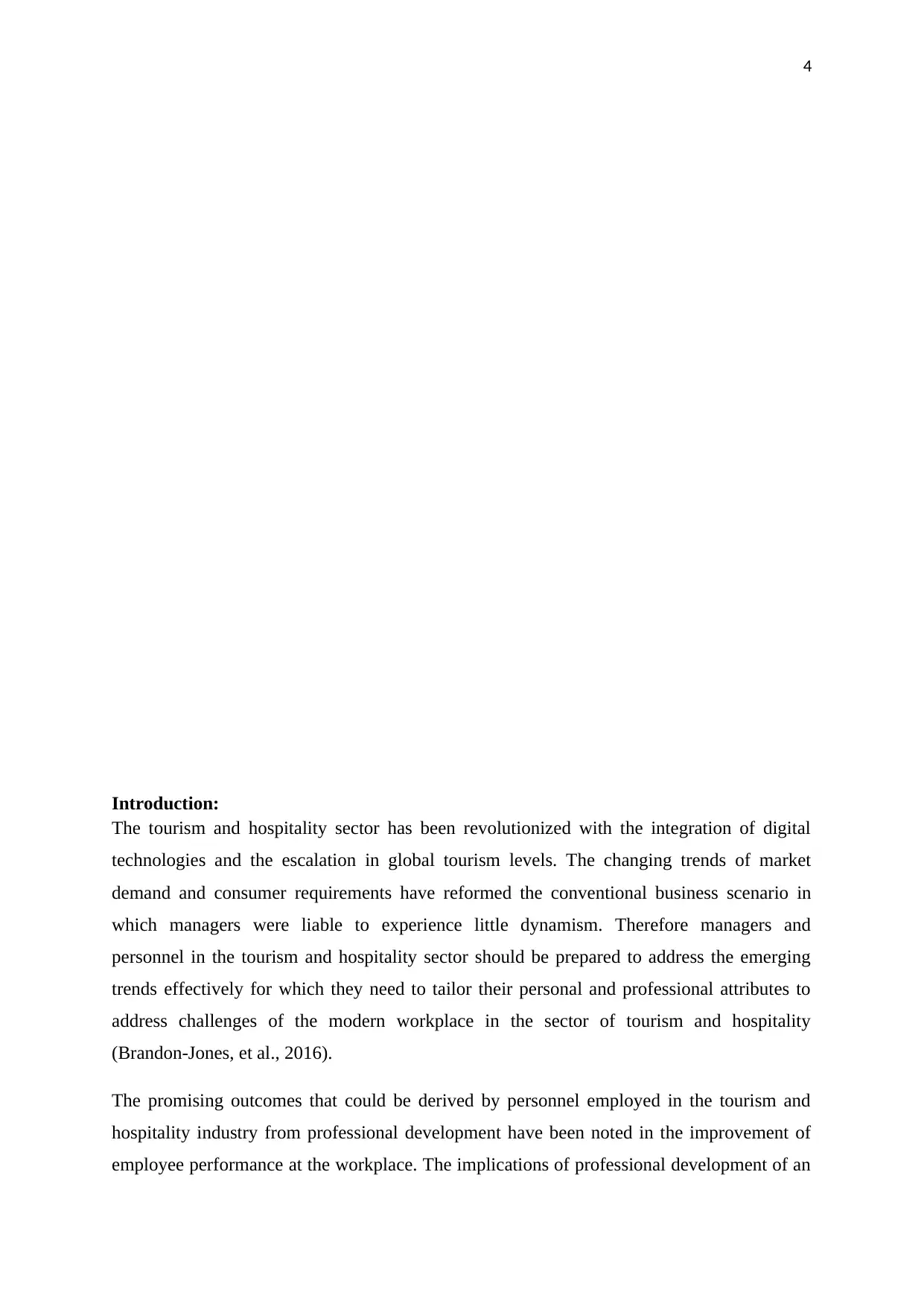
4
Introduction:
The tourism and hospitality sector has been revolutionized with the integration of digital
technologies and the escalation in global tourism levels. The changing trends of market
demand and consumer requirements have reformed the conventional business scenario in
which managers were liable to experience little dynamism. Therefore managers and
personnel in the tourism and hospitality sector should be prepared to address the emerging
trends effectively for which they need to tailor their personal and professional attributes to
address challenges of the modern workplace in the sector of tourism and hospitality
(Brandon-Jones, et al., 2016).
The promising outcomes that could be derived by personnel employed in the tourism and
hospitality industry from professional development have been noted in the improvement of
employee performance at the workplace. The implications of professional development of an
Introduction:
The tourism and hospitality sector has been revolutionized with the integration of digital
technologies and the escalation in global tourism levels. The changing trends of market
demand and consumer requirements have reformed the conventional business scenario in
which managers were liable to experience little dynamism. Therefore managers and
personnel in the tourism and hospitality sector should be prepared to address the emerging
trends effectively for which they need to tailor their personal and professional attributes to
address challenges of the modern workplace in the sector of tourism and hospitality
(Brandon-Jones, et al., 2016).
The promising outcomes that could be derived by personnel employed in the tourism and
hospitality industry from professional development have been noted in the improvement of
employee performance at the workplace. The implications of professional development of an
Secure Best Marks with AI Grader
Need help grading? Try our AI Grader for instant feedback on your assignments.

5
individual are realized through a comprehensive perception of one’s own self in order to
identify the areas of strength and weaknesses. The following report is aimed at presenting a
model for my professional development which includes an analysis of the specific
dimensions such as personality type, leadership, values and motivators, emotional
intelligence, decision making and capability for influencing people.
In whole assignment Take references and models as well
from textbook (for text book go to https://learn.scu.edu.au/
then put id: jjosep12 password: 21091987, then select
Tourism and Hotel professional development, then go to
study guide and select topics. I had written the topic
number in front of every heading for example:
(personality: topic 3 and 4)
Self-Awareness
2.1 Personality: topic 3 and 4 (explain myers briggs model and
big five model. Relate model with me as my career)
Conducting the personality test is an imperative for initiating professional development.
Using the Myers-Briggs Type Indicator as shown in Appendix, I found that my preferences
were inclined towards Introversion, Intuition, Thinking and Perception. In order to anticipate
these results it is necessary to obtain an understanding of the Myers-Briggs Type Indicator
test. The theory is based on four sets of preferences which characterize the personality of an
individual.
The first set of preferences refers to extraversion and introversion which imply that the
former is associated with the interaction with people and things while the latter is emphasized
on information and ideas. I could observe that my social skills were not sufficient and I relied
largely on information for performing my duties at the workplace. The impact of
individual are realized through a comprehensive perception of one’s own self in order to
identify the areas of strength and weaknesses. The following report is aimed at presenting a
model for my professional development which includes an analysis of the specific
dimensions such as personality type, leadership, values and motivators, emotional
intelligence, decision making and capability for influencing people.
In whole assignment Take references and models as well
from textbook (for text book go to https://learn.scu.edu.au/
then put id: jjosep12 password: 21091987, then select
Tourism and Hotel professional development, then go to
study guide and select topics. I had written the topic
number in front of every heading for example:
(personality: topic 3 and 4)
Self-Awareness
2.1 Personality: topic 3 and 4 (explain myers briggs model and
big five model. Relate model with me as my career)
Conducting the personality test is an imperative for initiating professional development.
Using the Myers-Briggs Type Indicator as shown in Appendix, I found that my preferences
were inclined towards Introversion, Intuition, Thinking and Perception. In order to anticipate
these results it is necessary to obtain an understanding of the Myers-Briggs Type Indicator
test. The theory is based on four sets of preferences which characterize the personality of an
individual.
The first set of preferences refers to extraversion and introversion which imply that the
former is associated with the interaction with people and things while the latter is emphasized
on information and ideas. I could observe that my social skills were not sufficient and I relied
largely on information for performing my duties at the workplace. The impact of

6
introversion in context of my career choices would imply searching for job
opportunities which have minimal requirement for social interaction. However, the
tourism and hospitality sector could not exclude the prospects of communication which
reflect on the setback posed by introversion traits for my future career choices (Ashton,
2015). The second set of preferences comprises of sensing and intuition among which the
former implies that sensing is associated with an individual’s dependence on facts and reality.
These preferences in the personality of an individual characterize the information processing
approach followed by an individual. On the contrary, the aspects of intuition can be validated
in an individual based on possibilities and personal capabilities. I observed that my emphasis
on personal competences and the possibilities that can be anticipated in every scenario
classify my preference towards intuition. These traits could enable me to obtain feasible
opportunities in future career choices where I could engage in consistent recognition of
opportunities in the workplace environment and its benefits for my professional
development (Blair et al., 2002).
The third set of preferences is characterized by the contrasting traits of thinking and feeling
among which the former encourages emphasis on logic and truth while the latter prefers
values and relationships in decision making. This trait would enable me to acquire an
interpretation of feasible future career choices in position of strategic management or
leadership where I could implement my personality traits for effective decision makings
(Hamm et al., 2016). The fourth set of preferences highlight the nature of lifestyle of an
individual and classified into judging and perception. The preference for judging would
indicate a planned and stable lifestyle while perception would imply a flexible and responsive
lifestyle. In my case, I could observe that my preferences were inclined towards perception
owing to my abilities for adapting to different living situations. The reflection on a
perception type of personality trait in context of my future career choices requires the
identification of jobs which could provide challenging environments. Perception
personality trait would be helpful for adapting to different scenarios emerging in
contemporary workplace (Moeller & Goldstein, 2014). Comparison of the insights drawn
from Myers-Briggs Theory with the Big Five personality model would facilitate a clearer
impression of an individual’s personality.
The Big Five personality model classifies an individual’s personality on the basis of scores in
individual dimensions such as Openness, Conscientiousness, Extraversion, Agreeableness
and Neuroticism. The comparison of my personalityinsights from Myers-Briggs Personality
introversion in context of my career choices would imply searching for job
opportunities which have minimal requirement for social interaction. However, the
tourism and hospitality sector could not exclude the prospects of communication which
reflect on the setback posed by introversion traits for my future career choices (Ashton,
2015). The second set of preferences comprises of sensing and intuition among which the
former implies that sensing is associated with an individual’s dependence on facts and reality.
These preferences in the personality of an individual characterize the information processing
approach followed by an individual. On the contrary, the aspects of intuition can be validated
in an individual based on possibilities and personal capabilities. I observed that my emphasis
on personal competences and the possibilities that can be anticipated in every scenario
classify my preference towards intuition. These traits could enable me to obtain feasible
opportunities in future career choices where I could engage in consistent recognition of
opportunities in the workplace environment and its benefits for my professional
development (Blair et al., 2002).
The third set of preferences is characterized by the contrasting traits of thinking and feeling
among which the former encourages emphasis on logic and truth while the latter prefers
values and relationships in decision making. This trait would enable me to acquire an
interpretation of feasible future career choices in position of strategic management or
leadership where I could implement my personality traits for effective decision makings
(Hamm et al., 2016). The fourth set of preferences highlight the nature of lifestyle of an
individual and classified into judging and perception. The preference for judging would
indicate a planned and stable lifestyle while perception would imply a flexible and responsive
lifestyle. In my case, I could observe that my preferences were inclined towards perception
owing to my abilities for adapting to different living situations. The reflection on a
perception type of personality trait in context of my future career choices requires the
identification of jobs which could provide challenging environments. Perception
personality trait would be helpful for adapting to different scenarios emerging in
contemporary workplace (Moeller & Goldstein, 2014). Comparison of the insights drawn
from Myers-Briggs Theory with the Big Five personality model would facilitate a clearer
impression of an individual’s personality.
The Big Five personality model classifies an individual’s personality on the basis of scores in
individual dimensions such as Openness, Conscientiousness, Extraversion, Agreeableness
and Neuroticism. The comparison of my personalityinsights from Myers-Briggs Personality
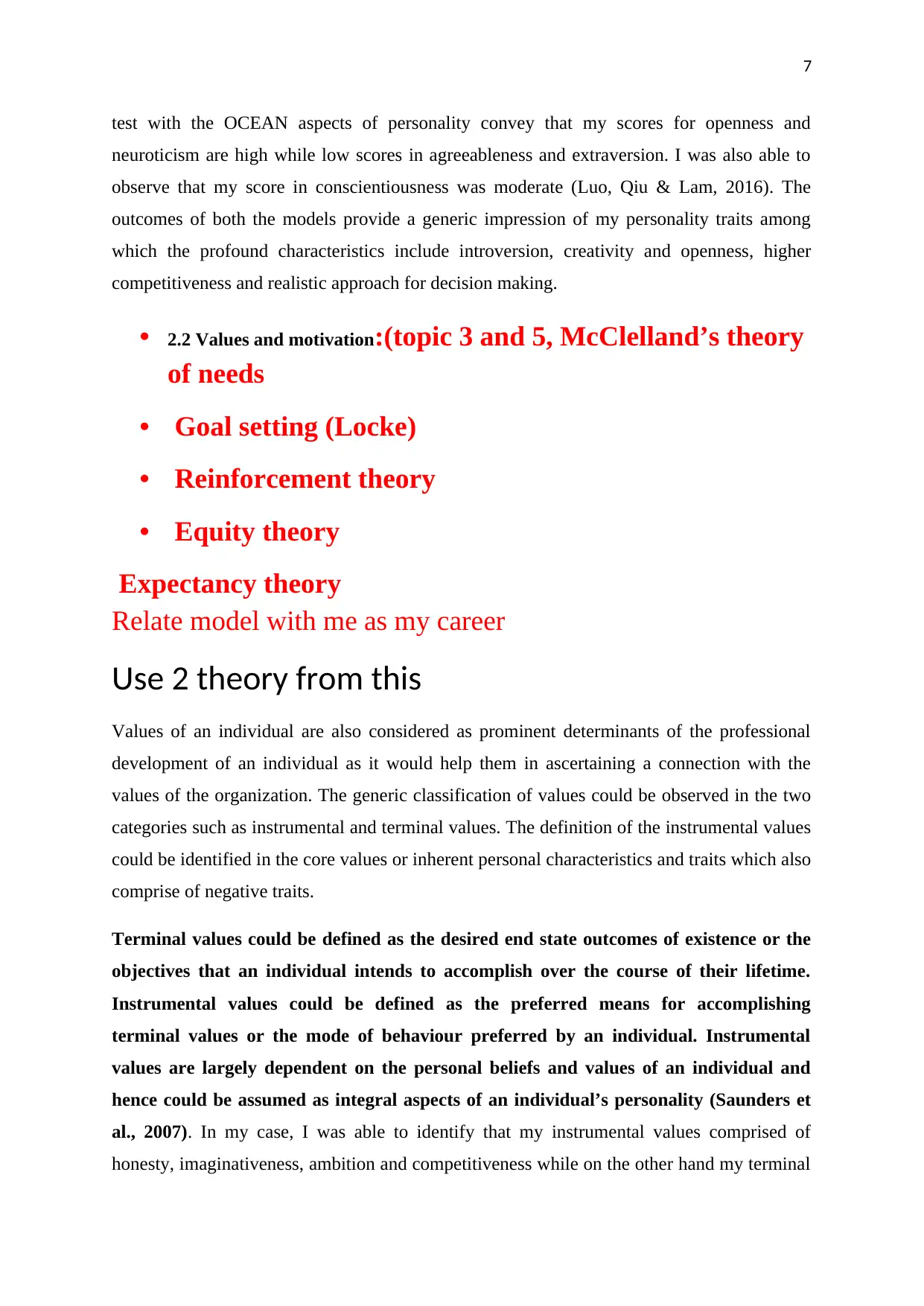
7
test with the OCEAN aspects of personality convey that my scores for openness and
neuroticism are high while low scores in agreeableness and extraversion. I was also able to
observe that my score in conscientiousness was moderate (Luo, Qiu & Lam, 2016). The
outcomes of both the models provide a generic impression of my personality traits among
which the profound characteristics include introversion, creativity and openness, higher
competitiveness and realistic approach for decision making.
• 2.2 Values and motivation:(topic 3 and 5, McClelland’s theory
of needs
• Goal setting (Locke)
• Reinforcement theory
• Equity theory
Expectancy theory
Relate model with me as my career
Use 2 theory from this
Values of an individual are also considered as prominent determinants of the professional
development of an individual as it would help them in ascertaining a connection with the
values of the organization. The generic classification of values could be observed in the two
categories such as instrumental and terminal values. The definition of the instrumental values
could be identified in the core values or inherent personal characteristics and traits which also
comprise of negative traits.
Terminal values could be defined as the desired end state outcomes of existence or the
objectives that an individual intends to accomplish over the course of their lifetime.
Instrumental values could be defined as the preferred means for accomplishing
terminal values or the mode of behaviour preferred by an individual. Instrumental
values are largely dependent on the personal beliefs and values of an individual and
hence could be assumed as integral aspects of an individual’s personality (Saunders et
al., 2007). In my case, I was able to identify that my instrumental values comprised of
honesty, imaginativeness, ambition and competitiveness while on the other hand my terminal
test with the OCEAN aspects of personality convey that my scores for openness and
neuroticism are high while low scores in agreeableness and extraversion. I was also able to
observe that my score in conscientiousness was moderate (Luo, Qiu & Lam, 2016). The
outcomes of both the models provide a generic impression of my personality traits among
which the profound characteristics include introversion, creativity and openness, higher
competitiveness and realistic approach for decision making.
• 2.2 Values and motivation:(topic 3 and 5, McClelland’s theory
of needs
• Goal setting (Locke)
• Reinforcement theory
• Equity theory
Expectancy theory
Relate model with me as my career
Use 2 theory from this
Values of an individual are also considered as prominent determinants of the professional
development of an individual as it would help them in ascertaining a connection with the
values of the organization. The generic classification of values could be observed in the two
categories such as instrumental and terminal values. The definition of the instrumental values
could be identified in the core values or inherent personal characteristics and traits which also
comprise of negative traits.
Terminal values could be defined as the desired end state outcomes of existence or the
objectives that an individual intends to accomplish over the course of their lifetime.
Instrumental values could be defined as the preferred means for accomplishing
terminal values or the mode of behaviour preferred by an individual. Instrumental
values are largely dependent on the personal beliefs and values of an individual and
hence could be assumed as integral aspects of an individual’s personality (Saunders et
al., 2007). In my case, I was able to identify that my instrumental values comprised of
honesty, imaginativeness, ambition and competitiveness while on the other hand my terminal
Paraphrase This Document
Need a fresh take? Get an instant paraphrase of this document with our AI Paraphraser
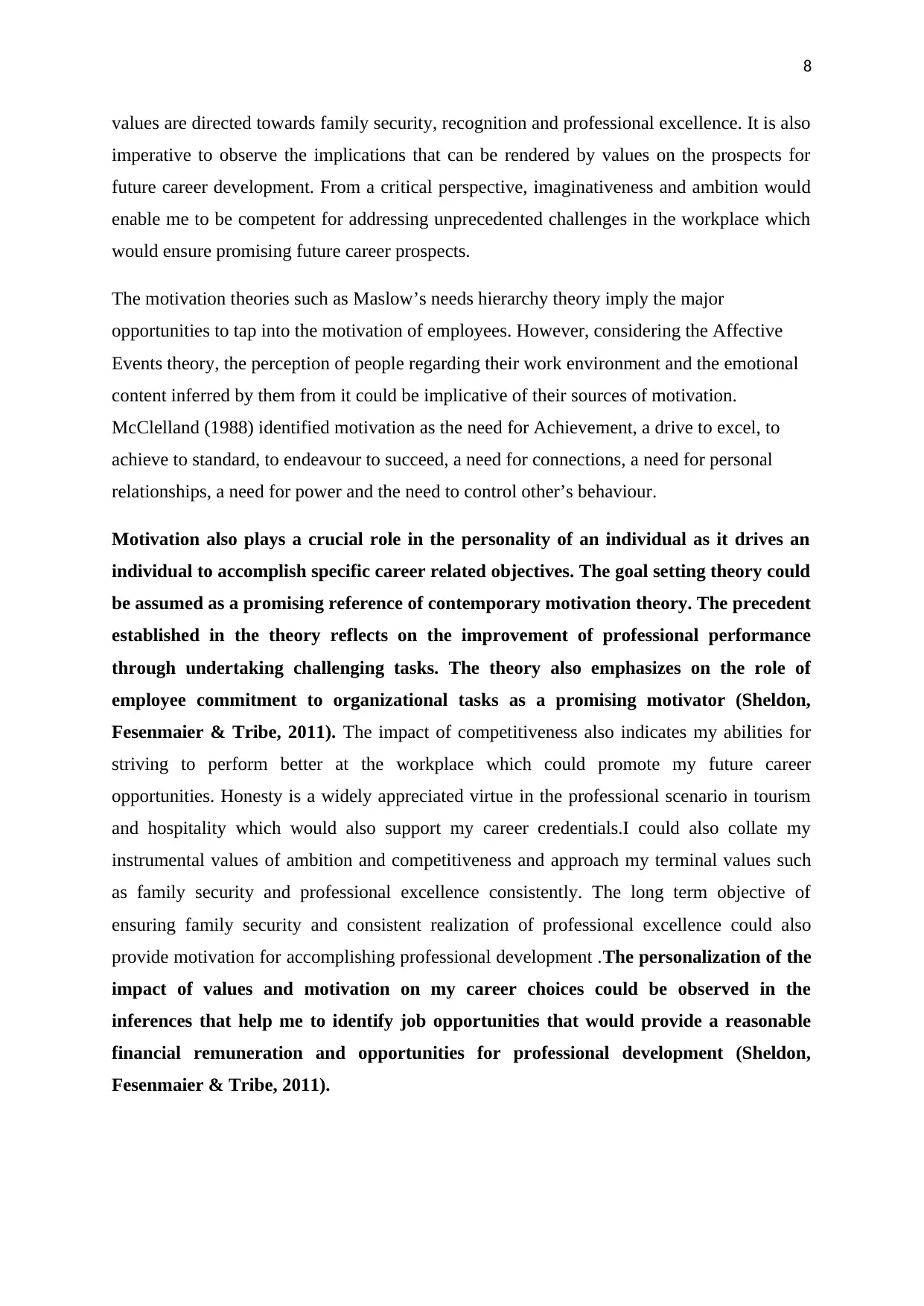
8
values are directed towards family security, recognition and professional excellence. It is also
imperative to observe the implications that can be rendered by values on the prospects for
future career development. From a critical perspective, imaginativeness and ambition would
enable me to be competent for addressing unprecedented challenges in the workplace which
would ensure promising future career prospects.
The motivation theories such as Maslow’s needs hierarchy theory imply the major
opportunities to tap into the motivation of employees. However, considering the Affective
Events theory, the perception of people regarding their work environment and the emotional
content inferred by them from it could be implicative of their sources of motivation.
McClelland (1988) identified motivation as the need for Achievement, a drive to excel, to
achieve to standard, to endeavour to succeed, a need for connections, a need for personal
relationships, a need for power and the need to control other’s behaviour.
Motivation also plays a crucial role in the personality of an individual as it drives an
individual to accomplish specific career related objectives. The goal setting theory could
be assumed as a promising reference of contemporary motivation theory. The precedent
established in the theory reflects on the improvement of professional performance
through undertaking challenging tasks. The theory also emphasizes on the role of
employee commitment to organizational tasks as a promising motivator (Sheldon,
Fesenmaier & Tribe, 2011). The impact of competitiveness also indicates my abilities for
striving to perform better at the workplace which could promote my future career
opportunities. Honesty is a widely appreciated virtue in the professional scenario in tourism
and hospitality which would also support my career credentials.I could also collate my
instrumental values of ambition and competitiveness and approach my terminal values such
as family security and professional excellence consistently. The long term objective of
ensuring family security and consistent realization of professional excellence could also
provide motivation for accomplishing professional development .The personalization of the
impact of values and motivation on my career choices could be observed in the
inferences that help me to identify job opportunities that would provide a reasonable
financial remuneration and opportunities for professional development (Sheldon,
Fesenmaier & Tribe, 2011).
values are directed towards family security, recognition and professional excellence. It is also
imperative to observe the implications that can be rendered by values on the prospects for
future career development. From a critical perspective, imaginativeness and ambition would
enable me to be competent for addressing unprecedented challenges in the workplace which
would ensure promising future career prospects.
The motivation theories such as Maslow’s needs hierarchy theory imply the major
opportunities to tap into the motivation of employees. However, considering the Affective
Events theory, the perception of people regarding their work environment and the emotional
content inferred by them from it could be implicative of their sources of motivation.
McClelland (1988) identified motivation as the need for Achievement, a drive to excel, to
achieve to standard, to endeavour to succeed, a need for connections, a need for personal
relationships, a need for power and the need to control other’s behaviour.
Motivation also plays a crucial role in the personality of an individual as it drives an
individual to accomplish specific career related objectives. The goal setting theory could
be assumed as a promising reference of contemporary motivation theory. The precedent
established in the theory reflects on the improvement of professional performance
through undertaking challenging tasks. The theory also emphasizes on the role of
employee commitment to organizational tasks as a promising motivator (Sheldon,
Fesenmaier & Tribe, 2011). The impact of competitiveness also indicates my abilities for
striving to perform better at the workplace which could promote my future career
opportunities. Honesty is a widely appreciated virtue in the professional scenario in tourism
and hospitality which would also support my career credentials.I could also collate my
instrumental values of ambition and competitiveness and approach my terminal values such
as family security and professional excellence consistently. The long term objective of
ensuring family security and consistent realization of professional excellence could also
provide motivation for accomplishing professional development .The personalization of the
impact of values and motivation on my career choices could be observed in the
inferences that help me to identify job opportunities that would provide a reasonable
financial remuneration and opportunities for professional development (Sheldon,
Fesenmaier & Tribe, 2011).

9
2.3 Emotional intelligence (topic 6)
The application of emotions and moods in organizational behaviour could be used to reflect
profoundly on the aspects of emotional intelligence. Emotional intelligence has been
substantially influenced by the introduction of theories such as emotional intelligence
theory that was developed through inferences from the works of Peter Salovey, John
‘Jack’ Mayer and Howard Gardner. The primary aspects addressed through emotional
intelligence refer to the five domains such as knowledge of emotions, self-motivation,
and management of personal emotions, relationship management and recognition of
emotions of other people (Walker & Moscardo, 2014). The different applications of
emotions and moods in context of organizational behaviour could be apprehended in the
distinct areas of selection processes implemented in an organization, negotiation, job
attitudes, customer service, and deviation in workplace behaviour, creativity, leadership,
motivation, interpersonal conflict and decision making.
The selection aspect of an organization should include references to emotional intelligence of
the employees to be recruited which are important in the case of jobs which require higher
degree of social interaction. The implementation of emotional intelligence measurements
during the recruitment and selection of employees could be accounted as promising measures
for inclusion of employees with higher abilities for social interaction. My competences could
be limited in this context (Seyitoğlu & Yirik, 2015).
Application of emotions in creativity aspect could imply that better moods provide the
opportunity for developing creative thinking. The particular implications for applying
emotions and moods in creativity in my case are strong as I have the capability for delivering
creative solutions to problems. Motivation of employees in an organization has also been a
major aspect addressed by the application of emotions and moods.
The motivation of an individual is largely dependent on emotional commitment which can be
profoundly observed in the physical and cognitive involvement of employees in the
organizational framework. I am able to infer that my emotional intelligence in this aspect
could be higher owing to my commitment to professional goals.
The application of emotions and moods is also observed in the case of leadership which can
be ensured through the emotional capability of an employee to align with the organization’s
values and beliefs alongside preparing for potential changes in the future. Leaders should
2.3 Emotional intelligence (topic 6)
The application of emotions and moods in organizational behaviour could be used to reflect
profoundly on the aspects of emotional intelligence. Emotional intelligence has been
substantially influenced by the introduction of theories such as emotional intelligence
theory that was developed through inferences from the works of Peter Salovey, John
‘Jack’ Mayer and Howard Gardner. The primary aspects addressed through emotional
intelligence refer to the five domains such as knowledge of emotions, self-motivation,
and management of personal emotions, relationship management and recognition of
emotions of other people (Walker & Moscardo, 2014). The different applications of
emotions and moods in context of organizational behaviour could be apprehended in the
distinct areas of selection processes implemented in an organization, negotiation, job
attitudes, customer service, and deviation in workplace behaviour, creativity, leadership,
motivation, interpersonal conflict and decision making.
The selection aspect of an organization should include references to emotional intelligence of
the employees to be recruited which are important in the case of jobs which require higher
degree of social interaction. The implementation of emotional intelligence measurements
during the recruitment and selection of employees could be accounted as promising measures
for inclusion of employees with higher abilities for social interaction. My competences could
be limited in this context (Seyitoğlu & Yirik, 2015).
Application of emotions in creativity aspect could imply that better moods provide the
opportunity for developing creative thinking. The particular implications for applying
emotions and moods in creativity in my case are strong as I have the capability for delivering
creative solutions to problems. Motivation of employees in an organization has also been a
major aspect addressed by the application of emotions and moods.
The motivation of an individual is largely dependent on emotional commitment which can be
profoundly observed in the physical and cognitive involvement of employees in the
organizational framework. I am able to infer that my emotional intelligence in this aspect
could be higher owing to my commitment to professional goals.
The application of emotions and moods is also observed in the case of leadership which can
be ensured through the emotional capability of an employee to align with the organization’s
values and beliefs alongside preparing for potential changes in the future. Leaders should

10
have the capability of framing emotions to address the objectives of change. In my case, I
was able to infer that my capabilities as a leader emotionally are limited due to introversion
and minimum capabilities for framing my emotions.I would identify with McClelland (1988)
need for relationships with colleagues, which are essential in the hospitality workplace.
Job attitudes are also influences by the emotions and moods of employees are also reflective
of the impact of emotional intelligence. The impact of emotions and moods on interpersonal
conflicts in an organization could also be observed since the conflicts between co-workers are
often associated with involvements of emotions. Therefore the requirement of emotional
intelligence can be profoundly observed in the above functions of an organization. The
effective application of emotional intelligence to these functions would enable the
identification of prolific career opportunities in the future.
2.4 Leadership: (topic 8
Transactional and Transformational models
Leadership is a prolific requirement in the domain of business management and is essential in
workplaces which are subject to dynamic changes. The impact of a leader is observed in
flexibility of employees to accomplish the desired objectives and ensure effective decision
making. The lack of employee’s ability to realize the outcomes of effective leadership could
be observed in the form of the lack of employee motivation, increasing interpersonal conflicts
and productivity.
The different forms of leadership styles which have been researched in varying academic
contexts include transformational, transactional, charismatic and visionary leadership. The
impact of transformational leadership could be observed in the capability for initiating change
and provide necessary motivation required to adapt to the change.
The implications of transactional leadership could be observed in the motivation of
employees by leaders on the basis of transactions and is accounted as one of the basic
leadership styles along the lines of autocratic and democratic leadership. Charismatic leaders
could be identified with the characteristics of transforming the values and beliefs of others to
align with their own. Academic research also illustrates visionary leadership that
characterizes the capabilities and motivation of leaders to transform vision into real
objectives.
have the capability of framing emotions to address the objectives of change. In my case, I
was able to infer that my capabilities as a leader emotionally are limited due to introversion
and minimum capabilities for framing my emotions.I would identify with McClelland (1988)
need for relationships with colleagues, which are essential in the hospitality workplace.
Job attitudes are also influences by the emotions and moods of employees are also reflective
of the impact of emotional intelligence. The impact of emotions and moods on interpersonal
conflicts in an organization could also be observed since the conflicts between co-workers are
often associated with involvements of emotions. Therefore the requirement of emotional
intelligence can be profoundly observed in the above functions of an organization. The
effective application of emotional intelligence to these functions would enable the
identification of prolific career opportunities in the future.
2.4 Leadership: (topic 8
Transactional and Transformational models
Leadership is a prolific requirement in the domain of business management and is essential in
workplaces which are subject to dynamic changes. The impact of a leader is observed in
flexibility of employees to accomplish the desired objectives and ensure effective decision
making. The lack of employee’s ability to realize the outcomes of effective leadership could
be observed in the form of the lack of employee motivation, increasing interpersonal conflicts
and productivity.
The different forms of leadership styles which have been researched in varying academic
contexts include transformational, transactional, charismatic and visionary leadership. The
impact of transformational leadership could be observed in the capability for initiating change
and provide necessary motivation required to adapt to the change.
The implications of transactional leadership could be observed in the motivation of
employees by leaders on the basis of transactions and is accounted as one of the basic
leadership styles along the lines of autocratic and democratic leadership. Charismatic leaders
could be identified with the characteristics of transforming the values and beliefs of others to
align with their own. Academic research also illustrates visionary leadership that
characterizes the capabilities and motivation of leaders to transform vision into real
objectives.
Secure Best Marks with AI Grader
Need help grading? Try our AI Grader for instant feedback on your assignments.
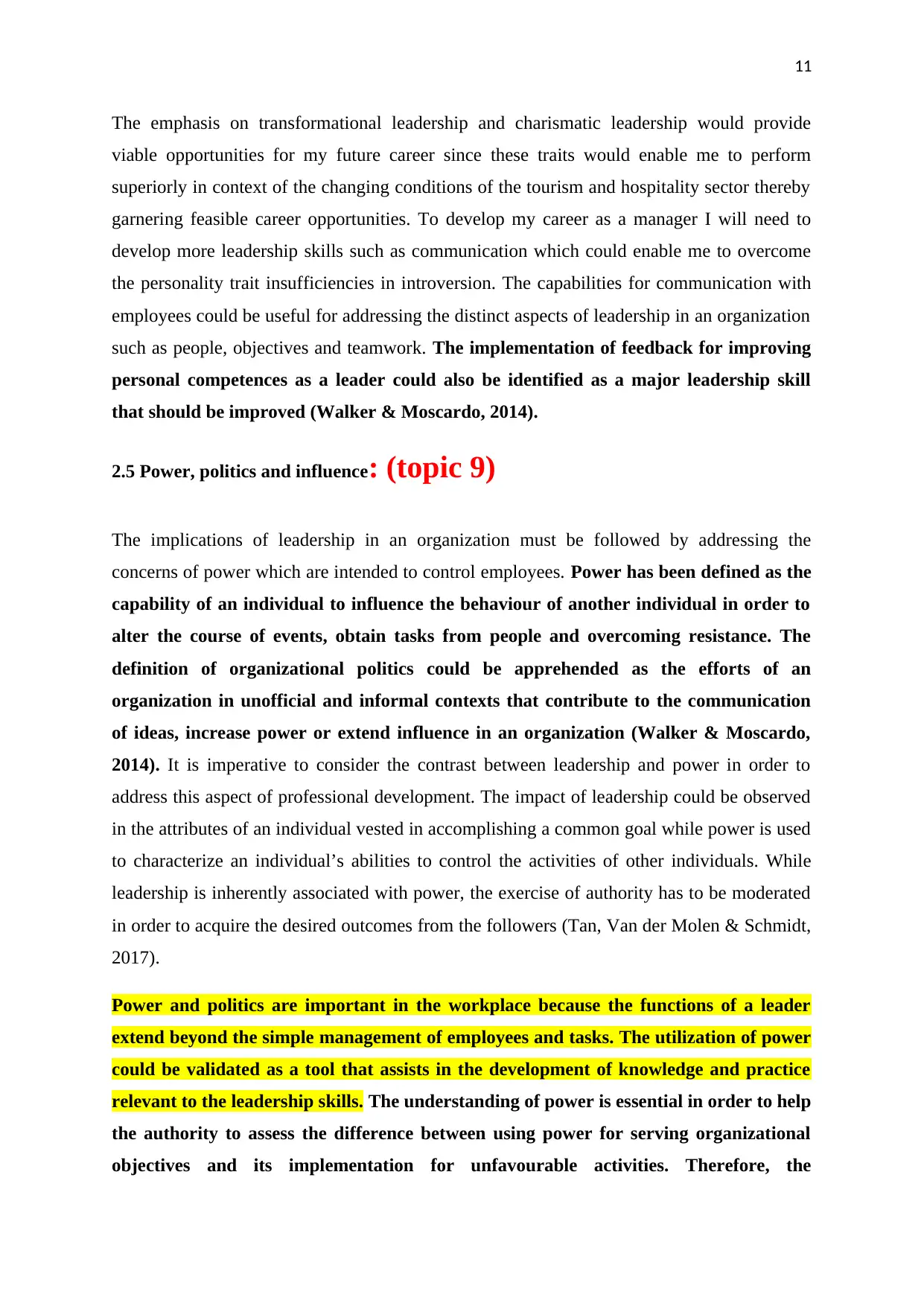
11
The emphasis on transformational leadership and charismatic leadership would provide
viable opportunities for my future career since these traits would enable me to perform
superiorly in context of the changing conditions of the tourism and hospitality sector thereby
garnering feasible career opportunities. To develop my career as a manager I will need to
develop more leadership skills such as communication which could enable me to overcome
the personality trait insufficiencies in introversion. The capabilities for communication with
employees could be useful for addressing the distinct aspects of leadership in an organization
such as people, objectives and teamwork. The implementation of feedback for improving
personal competences as a leader could also be identified as a major leadership skill
that should be improved (Walker & Moscardo, 2014).
2.5 Power, politics and influence: (topic 9)
The implications of leadership in an organization must be followed by addressing the
concerns of power which are intended to control employees. Power has been defined as the
capability of an individual to influence the behaviour of another individual in order to
alter the course of events, obtain tasks from people and overcoming resistance. The
definition of organizational politics could be apprehended as the efforts of an
organization in unofficial and informal contexts that contribute to the communication
of ideas, increase power or extend influence in an organization (Walker & Moscardo,
2014). It is imperative to consider the contrast between leadership and power in order to
address this aspect of professional development. The impact of leadership could be observed
in the attributes of an individual vested in accomplishing a common goal while power is used
to characterize an individual’s abilities to control the activities of other individuals. While
leadership is inherently associated with power, the exercise of authority has to be moderated
in order to acquire the desired outcomes from the followers (Tan, Van der Molen & Schmidt,
2017).
Power and politics are important in the workplace because the functions of a leader
extend beyond the simple management of employees and tasks. The utilization of power
could be validated as a tool that assists in the development of knowledge and practice
relevant to the leadership skills. The understanding of power is essential in order to help
the authority to assess the difference between using power for serving organizational
objectives and its implementation for unfavourable activities. Therefore, the
The emphasis on transformational leadership and charismatic leadership would provide
viable opportunities for my future career since these traits would enable me to perform
superiorly in context of the changing conditions of the tourism and hospitality sector thereby
garnering feasible career opportunities. To develop my career as a manager I will need to
develop more leadership skills such as communication which could enable me to overcome
the personality trait insufficiencies in introversion. The capabilities for communication with
employees could be useful for addressing the distinct aspects of leadership in an organization
such as people, objectives and teamwork. The implementation of feedback for improving
personal competences as a leader could also be identified as a major leadership skill
that should be improved (Walker & Moscardo, 2014).
2.5 Power, politics and influence: (topic 9)
The implications of leadership in an organization must be followed by addressing the
concerns of power which are intended to control employees. Power has been defined as the
capability of an individual to influence the behaviour of another individual in order to
alter the course of events, obtain tasks from people and overcoming resistance. The
definition of organizational politics could be apprehended as the efforts of an
organization in unofficial and informal contexts that contribute to the communication
of ideas, increase power or extend influence in an organization (Walker & Moscardo,
2014). It is imperative to consider the contrast between leadership and power in order to
address this aspect of professional development. The impact of leadership could be observed
in the attributes of an individual vested in accomplishing a common goal while power is used
to characterize an individual’s abilities to control the activities of other individuals. While
leadership is inherently associated with power, the exercise of authority has to be moderated
in order to acquire the desired outcomes from the followers (Tan, Van der Molen & Schmidt,
2017).
Power and politics are important in the workplace because the functions of a leader
extend beyond the simple management of employees and tasks. The utilization of power
could be validated as a tool that assists in the development of knowledge and practice
relevant to the leadership skills. The understanding of power is essential in order to help
the authority to assess the difference between using power for serving organizational
objectives and its implementation for unfavourable activities. Therefore, the

12
comprehensive understanding of power could be helpful for individuals to acquire
respect and accomplish objectives while the lack of the same could lead to formidable
setbacks for organizational performance such as stagnation (Sheldon, Fesenmaier &
Tribe, 2011). The use of power responsibly is an effective support for professional
development. Another imperative factor to be considered in context of the differences
between leadership and power could be identified in the case of the pursuit of leadership for
acquiring power. The impact of power could be promising for my future career prospects
since I can use my authority to exercise effective leadership thereby realizing professional
excellence.
The distinct forms of power which could be observed in context of organizational
behaviour refer to legitimate power, charismatic power, reward power, political power,
coercive power and expert power. These different types of power are associated with
individual characteristics. Legitimate power is inherently associated with the position in
the workplace. Charismatic power is derived from the inherent personality of an
individual and is reflected in ability to influence the perspective of others. Reward
power is vested in an individual through authority on similar grounds as coercive power
only with the dependence of former on rewards and that of the latter on punishment.
Political power is derived from the observation of group support while expert power is
acquired through specialization in a distinct field of learning.
3.0 Decision making and planning: (topic 7)
The professional development of an individual is reliant on the capabilities for decision
making since effective decision making and planning competences could provide substantial
competitive advantage to an individual for acquiring a job prospect. Professional
development implies promotion in the strata of management of organizations which would
require an individual to address competences of decision making at different levels
effectively. The understanding of theoretical models such as rational decision making model
would provide viable insights for my professional development. Kolbs decision making
model relies on four distinct stages which comprise of diverging, assimilating, converging
and accommodating. The aspect of diverging could be apprehended as a combination of two
different types of learning style as observed in the case of other dimensions of the model. The
different learning styles which provide an insight into the particular highlights of Kolb’s
comprehensive understanding of power could be helpful for individuals to acquire
respect and accomplish objectives while the lack of the same could lead to formidable
setbacks for organizational performance such as stagnation (Sheldon, Fesenmaier &
Tribe, 2011). The use of power responsibly is an effective support for professional
development. Another imperative factor to be considered in context of the differences
between leadership and power could be identified in the case of the pursuit of leadership for
acquiring power. The impact of power could be promising for my future career prospects
since I can use my authority to exercise effective leadership thereby realizing professional
excellence.
The distinct forms of power which could be observed in context of organizational
behaviour refer to legitimate power, charismatic power, reward power, political power,
coercive power and expert power. These different types of power are associated with
individual characteristics. Legitimate power is inherently associated with the position in
the workplace. Charismatic power is derived from the inherent personality of an
individual and is reflected in ability to influence the perspective of others. Reward
power is vested in an individual through authority on similar grounds as coercive power
only with the dependence of former on rewards and that of the latter on punishment.
Political power is derived from the observation of group support while expert power is
acquired through specialization in a distinct field of learning.
3.0 Decision making and planning: (topic 7)
The professional development of an individual is reliant on the capabilities for decision
making since effective decision making and planning competences could provide substantial
competitive advantage to an individual for acquiring a job prospect. Professional
development implies promotion in the strata of management of organizations which would
require an individual to address competences of decision making at different levels
effectively. The understanding of theoretical models such as rational decision making model
would provide viable insights for my professional development. Kolbs decision making
model relies on four distinct stages which comprise of diverging, assimilating, converging
and accommodating. The aspect of diverging could be apprehended as a combination of two
different types of learning style as observed in the case of other dimensions of the model. The
different learning styles which provide an insight into the particular highlights of Kolb’s
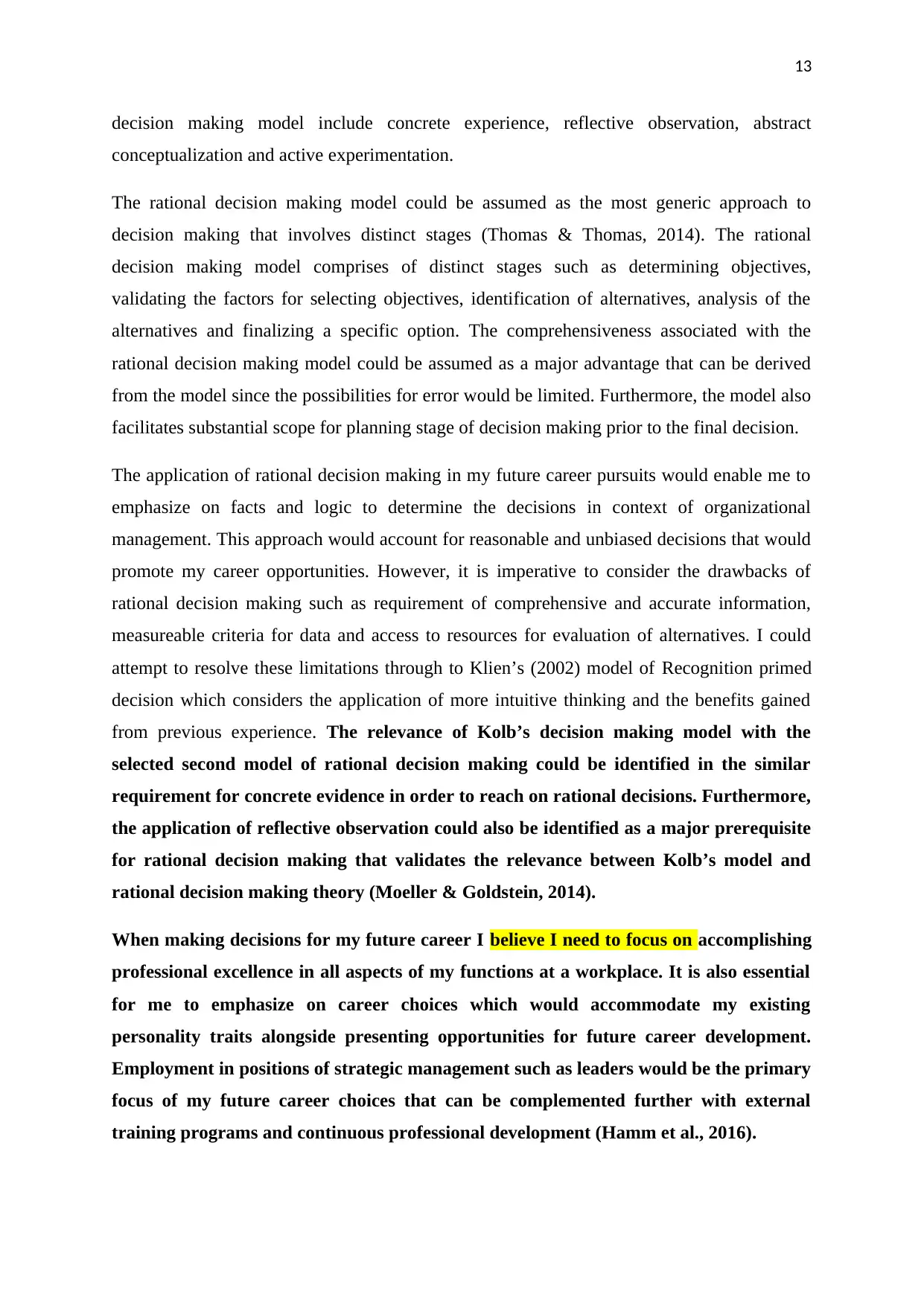
13
decision making model include concrete experience, reflective observation, abstract
conceptualization and active experimentation.
The rational decision making model could be assumed as the most generic approach to
decision making that involves distinct stages (Thomas & Thomas, 2014). The rational
decision making model comprises of distinct stages such as determining objectives,
validating the factors for selecting objectives, identification of alternatives, analysis of the
alternatives and finalizing a specific option. The comprehensiveness associated with the
rational decision making model could be assumed as a major advantage that can be derived
from the model since the possibilities for error would be limited. Furthermore, the model also
facilitates substantial scope for planning stage of decision making prior to the final decision.
The application of rational decision making in my future career pursuits would enable me to
emphasize on facts and logic to determine the decisions in context of organizational
management. This approach would account for reasonable and unbiased decisions that would
promote my career opportunities. However, it is imperative to consider the drawbacks of
rational decision making such as requirement of comprehensive and accurate information,
measureable criteria for data and access to resources for evaluation of alternatives. I could
attempt to resolve these limitations through to Klien’s (2002) model of Recognition primed
decision which considers the application of more intuitive thinking and the benefits gained
from previous experience. The relevance of Kolb’s decision making model with the
selected second model of rational decision making could be identified in the similar
requirement for concrete evidence in order to reach on rational decisions. Furthermore,
the application of reflective observation could also be identified as a major prerequisite
for rational decision making that validates the relevance between Kolb’s model and
rational decision making theory (Moeller & Goldstein, 2014).
When making decisions for my future career I believe I need to focus on accomplishing
professional excellence in all aspects of my functions at a workplace. It is also essential
for me to emphasize on career choices which would accommodate my existing
personality traits alongside presenting opportunities for future career development.
Employment in positions of strategic management such as leaders would be the primary
focus of my future career choices that can be complemented further with external
training programs and continuous professional development (Hamm et al., 2016).
decision making model include concrete experience, reflective observation, abstract
conceptualization and active experimentation.
The rational decision making model could be assumed as the most generic approach to
decision making that involves distinct stages (Thomas & Thomas, 2014). The rational
decision making model comprises of distinct stages such as determining objectives,
validating the factors for selecting objectives, identification of alternatives, analysis of the
alternatives and finalizing a specific option. The comprehensiveness associated with the
rational decision making model could be assumed as a major advantage that can be derived
from the model since the possibilities for error would be limited. Furthermore, the model also
facilitates substantial scope for planning stage of decision making prior to the final decision.
The application of rational decision making in my future career pursuits would enable me to
emphasize on facts and logic to determine the decisions in context of organizational
management. This approach would account for reasonable and unbiased decisions that would
promote my career opportunities. However, it is imperative to consider the drawbacks of
rational decision making such as requirement of comprehensive and accurate information,
measureable criteria for data and access to resources for evaluation of alternatives. I could
attempt to resolve these limitations through to Klien’s (2002) model of Recognition primed
decision which considers the application of more intuitive thinking and the benefits gained
from previous experience. The relevance of Kolb’s decision making model with the
selected second model of rational decision making could be identified in the similar
requirement for concrete evidence in order to reach on rational decisions. Furthermore,
the application of reflective observation could also be identified as a major prerequisite
for rational decision making that validates the relevance between Kolb’s model and
rational decision making theory (Moeller & Goldstein, 2014).
When making decisions for my future career I believe I need to focus on accomplishing
professional excellence in all aspects of my functions at a workplace. It is also essential
for me to emphasize on career choices which would accommodate my existing
personality traits alongside presenting opportunities for future career development.
Employment in positions of strategic management such as leaders would be the primary
focus of my future career choices that can be complemented further with external
training programs and continuous professional development (Hamm et al., 2016).
Paraphrase This Document
Need a fresh take? Get an instant paraphrase of this document with our AI Paraphraser
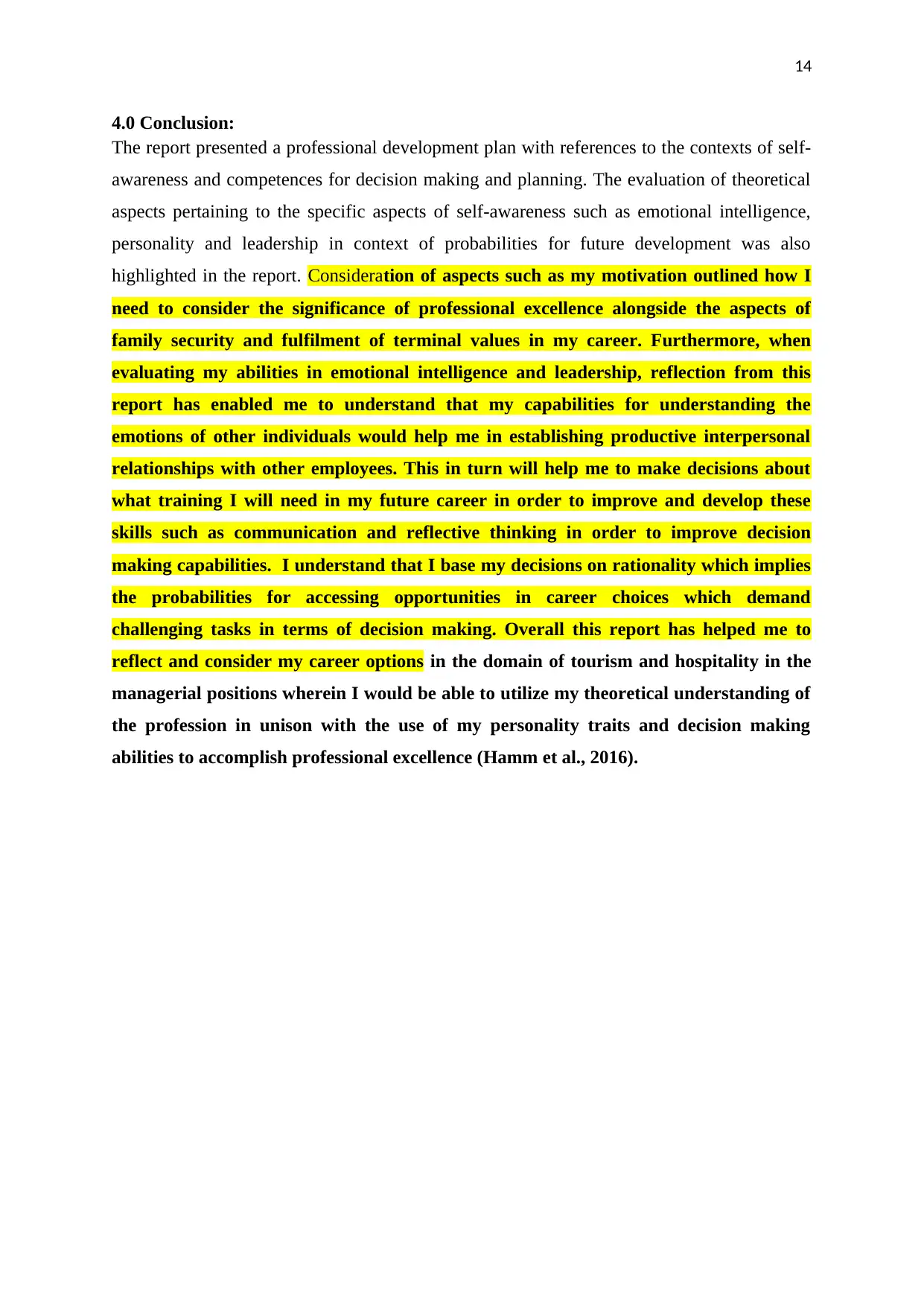
14
4.0 Conclusion:
The report presented a professional development plan with references to the contexts of self-
awareness and competences for decision making and planning. The evaluation of theoretical
aspects pertaining to the specific aspects of self-awareness such as emotional intelligence,
personality and leadership in context of probabilities for future development was also
highlighted in the report. Consideration of aspects such as my motivation outlined how I
need to consider the significance of professional excellence alongside the aspects of
family security and fulfilment of terminal values in my career. Furthermore, when
evaluating my abilities in emotional intelligence and leadership, reflection from this
report has enabled me to understand that my capabilities for understanding the
emotions of other individuals would help me in establishing productive interpersonal
relationships with other employees. This in turn will help me to make decisions about
what training I will need in my future career in order to improve and develop these
skills such as communication and reflective thinking in order to improve decision
making capabilities. I understand that I base my decisions on rationality which implies
the probabilities for accessing opportunities in career choices which demand
challenging tasks in terms of decision making. Overall this report has helped me to
reflect and consider my career options in the domain of tourism and hospitality in the
managerial positions wherein I would be able to utilize my theoretical understanding of
the profession in unison with the use of my personality traits and decision making
abilities to accomplish professional excellence (Hamm et al., 2016).
4.0 Conclusion:
The report presented a professional development plan with references to the contexts of self-
awareness and competences for decision making and planning. The evaluation of theoretical
aspects pertaining to the specific aspects of self-awareness such as emotional intelligence,
personality and leadership in context of probabilities for future development was also
highlighted in the report. Consideration of aspects such as my motivation outlined how I
need to consider the significance of professional excellence alongside the aspects of
family security and fulfilment of terminal values in my career. Furthermore, when
evaluating my abilities in emotional intelligence and leadership, reflection from this
report has enabled me to understand that my capabilities for understanding the
emotions of other individuals would help me in establishing productive interpersonal
relationships with other employees. This in turn will help me to make decisions about
what training I will need in my future career in order to improve and develop these
skills such as communication and reflective thinking in order to improve decision
making capabilities. I understand that I base my decisions on rationality which implies
the probabilities for accessing opportunities in career choices which demand
challenging tasks in terms of decision making. Overall this report has helped me to
reflect and consider my career options in the domain of tourism and hospitality in the
managerial positions wherein I would be able to utilize my theoretical understanding of
the profession in unison with the use of my personality traits and decision making
abilities to accomplish professional excellence (Hamm et al., 2016).
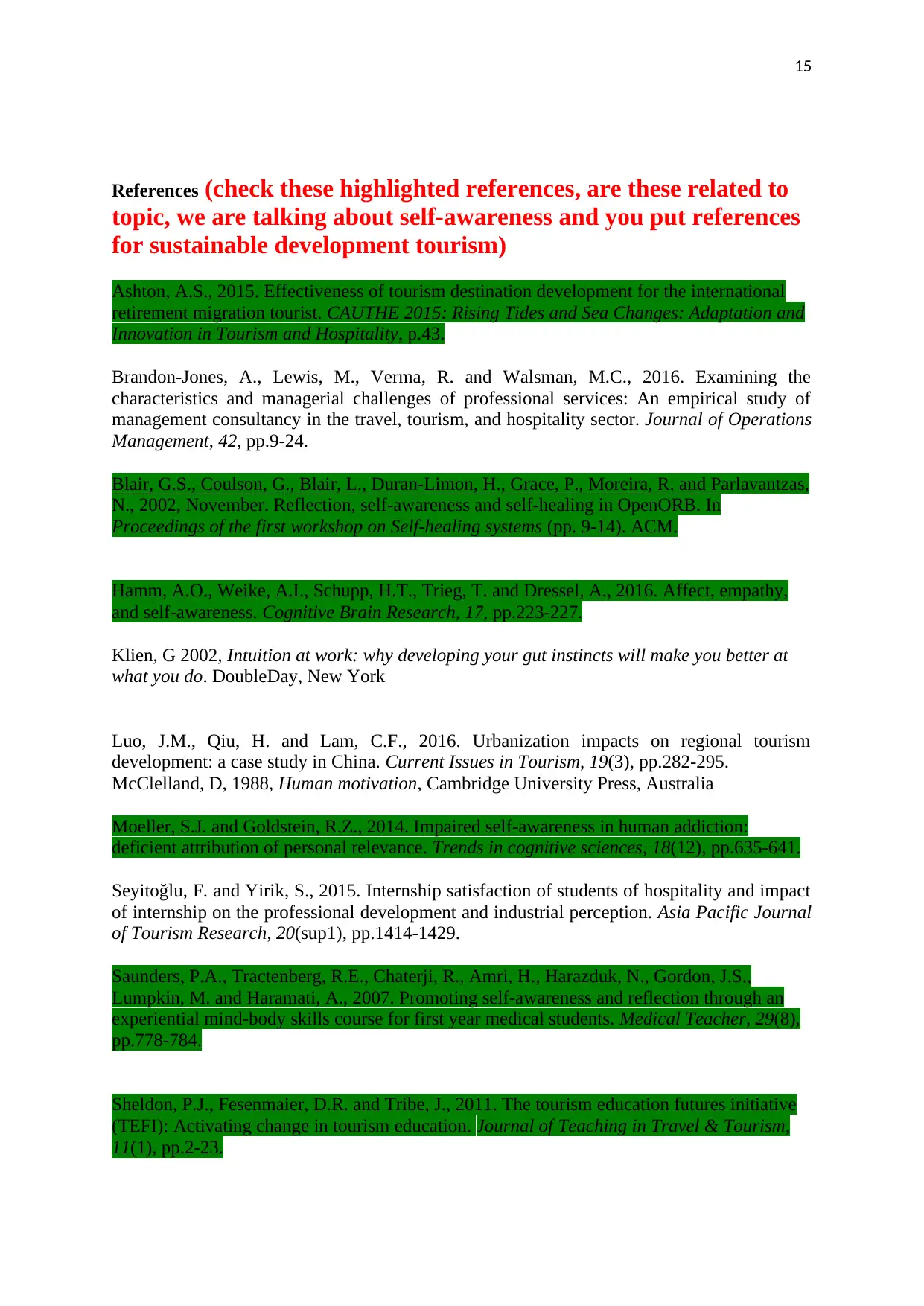
15
References (check these highlighted references, are these related to
topic, we are talking about self-awareness and you put references
for sustainable development tourism)
Ashton, A.S., 2015. Effectiveness of tourism destination development for the international
retirement migration tourist. CAUTHE 2015: Rising Tides and Sea Changes: Adaptation and
Innovation in Tourism and Hospitality, p.43.
Brandon-Jones, A., Lewis, M., Verma, R. and Walsman, M.C., 2016. Examining the
characteristics and managerial challenges of professional services: An empirical study of
management consultancy in the travel, tourism, and hospitality sector. Journal of Operations
Management, 42, pp.9-24.
Blair, G.S., Coulson, G., Blair, L., Duran-Limon, H., Grace, P., Moreira, R. and Parlavantzas,
N., 2002, November. Reflection, self-awareness and self-healing in OpenORB. In
Proceedings of the first workshop on Self-healing systems (pp. 9-14). ACM.
Hamm, A.O., Weike, A.I., Schupp, H.T., Trieg, T. and Dressel, A., 2016. Affect, empathy,
and self-awareness. Cognitive Brain Research, 17, pp.223-227.
Klien, G 2002, Intuition at work: why developing your gut instincts will make you better at
what you do. DoubleDay, New York
Luo, J.M., Qiu, H. and Lam, C.F., 2016. Urbanization impacts on regional tourism
development: a case study in China. Current Issues in Tourism, 19(3), pp.282-295.
McClelland, D, 1988, Human motivation, Cambridge University Press, Australia
Moeller, S.J. and Goldstein, R.Z., 2014. Impaired self-awareness in human addiction:
deficient attribution of personal relevance. Trends in cognitive sciences, 18(12), pp.635-641.
Seyitoğlu, F. and Yirik, S., 2015. Internship satisfaction of students of hospitality and impact
of internship on the professional development and industrial perception. Asia Pacific Journal
of Tourism Research, 20(sup1), pp.1414-1429.
Saunders, P.A., Tractenberg, R.E., Chaterji, R., Amri, H., Harazduk, N., Gordon, J.S.,
Lumpkin, M. and Haramati, A., 2007. Promoting self-awareness and reflection through an
experiential mind-body skills course for first year medical students. Medical Teacher, 29(8),
pp.778-784.
Sheldon, P.J., Fesenmaier, D.R. and Tribe, J., 2011. The tourism education futures initiative
(TEFI): Activating change in tourism education. Journal of Teaching in Travel & Tourism,
11(1), pp.2-23.
References (check these highlighted references, are these related to
topic, we are talking about self-awareness and you put references
for sustainable development tourism)
Ashton, A.S., 2015. Effectiveness of tourism destination development for the international
retirement migration tourist. CAUTHE 2015: Rising Tides and Sea Changes: Adaptation and
Innovation in Tourism and Hospitality, p.43.
Brandon-Jones, A., Lewis, M., Verma, R. and Walsman, M.C., 2016. Examining the
characteristics and managerial challenges of professional services: An empirical study of
management consultancy in the travel, tourism, and hospitality sector. Journal of Operations
Management, 42, pp.9-24.
Blair, G.S., Coulson, G., Blair, L., Duran-Limon, H., Grace, P., Moreira, R. and Parlavantzas,
N., 2002, November. Reflection, self-awareness and self-healing in OpenORB. In
Proceedings of the first workshop on Self-healing systems (pp. 9-14). ACM.
Hamm, A.O., Weike, A.I., Schupp, H.T., Trieg, T. and Dressel, A., 2016. Affect, empathy,
and self-awareness. Cognitive Brain Research, 17, pp.223-227.
Klien, G 2002, Intuition at work: why developing your gut instincts will make you better at
what you do. DoubleDay, New York
Luo, J.M., Qiu, H. and Lam, C.F., 2016. Urbanization impacts on regional tourism
development: a case study in China. Current Issues in Tourism, 19(3), pp.282-295.
McClelland, D, 1988, Human motivation, Cambridge University Press, Australia
Moeller, S.J. and Goldstein, R.Z., 2014. Impaired self-awareness in human addiction:
deficient attribution of personal relevance. Trends in cognitive sciences, 18(12), pp.635-641.
Seyitoğlu, F. and Yirik, S., 2015. Internship satisfaction of students of hospitality and impact
of internship on the professional development and industrial perception. Asia Pacific Journal
of Tourism Research, 20(sup1), pp.1414-1429.
Saunders, P.A., Tractenberg, R.E., Chaterji, R., Amri, H., Harazduk, N., Gordon, J.S.,
Lumpkin, M. and Haramati, A., 2007. Promoting self-awareness and reflection through an
experiential mind-body skills course for first year medical students. Medical Teacher, 29(8),
pp.778-784.
Sheldon, P.J., Fesenmaier, D.R. and Tribe, J., 2011. The tourism education futures initiative
(TEFI): Activating change in tourism education. Journal of Teaching in Travel & Tourism,
11(1), pp.2-23.
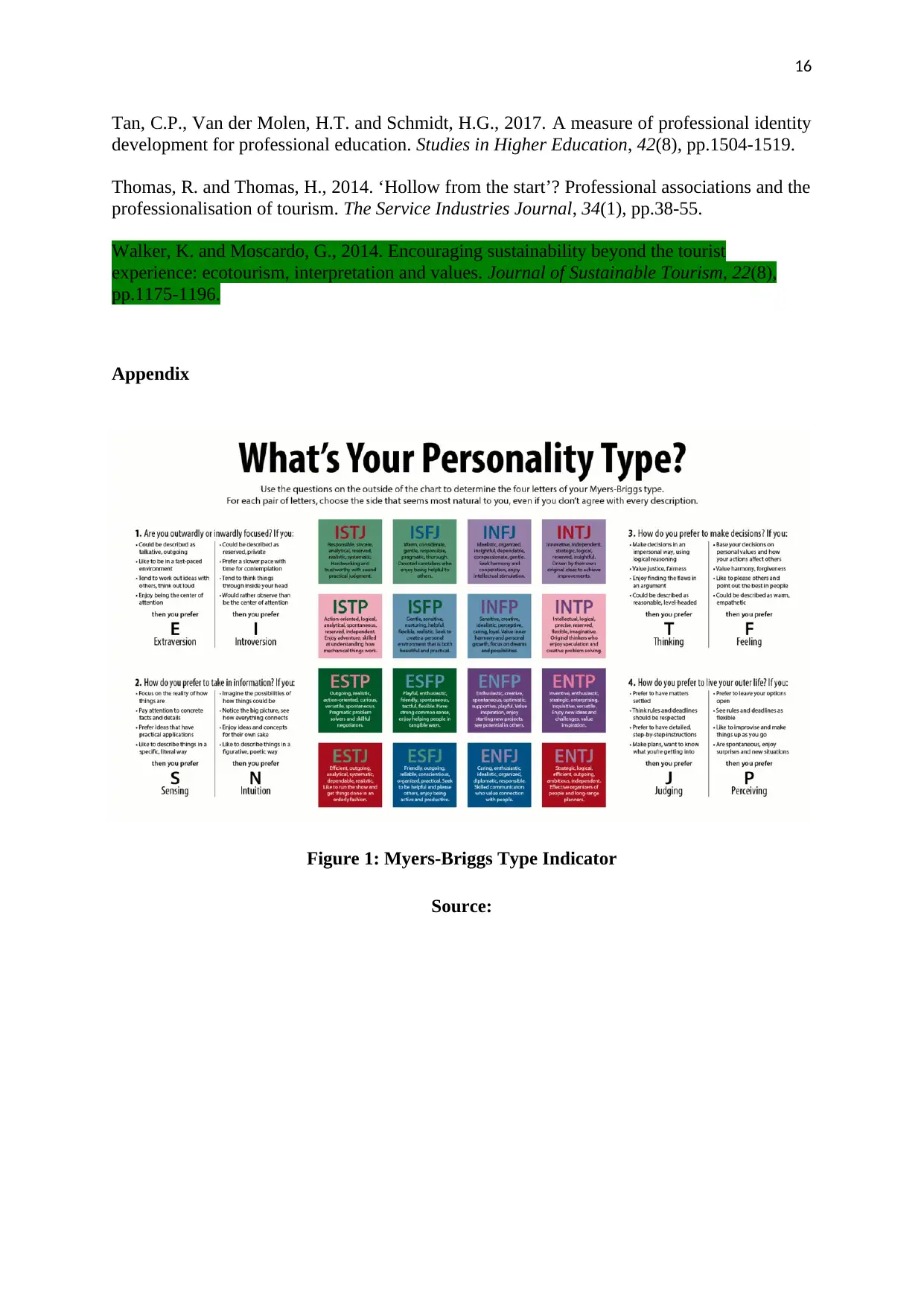
16
Tan, C.P., Van der Molen, H.T. and Schmidt, H.G., 2017. A measure of professional identity
development for professional education. Studies in Higher Education, 42(8), pp.1504-1519.
Thomas, R. and Thomas, H., 2014. ‘Hollow from the start’? Professional associations and the
professionalisation of tourism. The Service Industries Journal, 34(1), pp.38-55.
Walker, K. and Moscardo, G., 2014. Encouraging sustainability beyond the tourist
experience: ecotourism, interpretation and values. Journal of Sustainable Tourism, 22(8),
pp.1175-1196.
Appendix
Figure 1: Myers-Briggs Type Indicator
Source:
Tan, C.P., Van der Molen, H.T. and Schmidt, H.G., 2017. A measure of professional identity
development for professional education. Studies in Higher Education, 42(8), pp.1504-1519.
Thomas, R. and Thomas, H., 2014. ‘Hollow from the start’? Professional associations and the
professionalisation of tourism. The Service Industries Journal, 34(1), pp.38-55.
Walker, K. and Moscardo, G., 2014. Encouraging sustainability beyond the tourist
experience: ecotourism, interpretation and values. Journal of Sustainable Tourism, 22(8),
pp.1175-1196.
Appendix
Figure 1: Myers-Briggs Type Indicator
Source:
1 out of 16
Related Documents
Your All-in-One AI-Powered Toolkit for Academic Success.
+13062052269
info@desklib.com
Available 24*7 on WhatsApp / Email
![[object Object]](/_next/static/media/star-bottom.7253800d.svg)
Unlock your academic potential
© 2024 | Zucol Services PVT LTD | All rights reserved.




